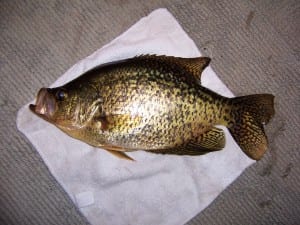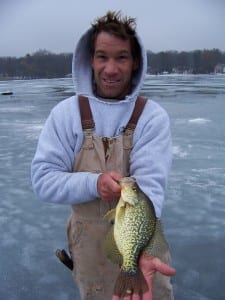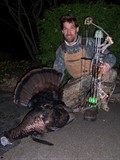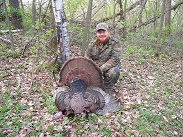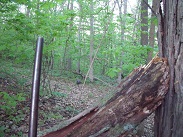Structure Fishing 202
By Paul Crawford
Advanced Structures
In our last article, we looked at the basics of structures and what to look for in a structure. This month, let’s look at some of the more unusual structures that have proven to outperform the normal ledges and holes. These are candidates to be honey holes, that can produce giant stringers on a consistant basis.
An old structure fishing adage, which is all too true, is: “If you are on a good structure and you’re not catching fish, it only means there’s something better near by.” In most cases this will be a difference in the cover. An isolated hydrilla ball on a ledge may draw fish from several hundred yards in all directions. But there is still the odd case, where the cover and depth remain fairly constant, and a “secondary structure” is the bass magnet. These honey holes have the huge advantage of not changing from year to year. Add good cover to a secondary structure and it’s almost a sure fire winner. For this reason, these more hidden structures are well worth the time, trouble, and gas to find. Once you’ve found one, remember it! It can produce fish year after year for you.
The Funnel
Funnels are some of the absolute best structures to be found when fish are moving between open water and shallow flats to feed or spawn. They are the main entrance to a flat and will not only hold a number of fish close, but will replenish themselves by the hour. Funnels are at their best during Spring and Fall, and expecially good for about an hour before and after both dawn and dusk.
A Funnel is an oversize cut in a flat’s ledge with gentle slopes on both points and a gentle slope up onto the flat. The most common example of a Funnel is a creek mouth in a resevior where the channel has filled in over time. Most Funnels can be found fairly close to shore and leads into only a few feet of water. Since this is a shallow water structure, cover is common, and since they are often old creek mouths, it’s not unusual to have a break in the surrounding cover right at the edge of the structure. On occassion, you can even find the reverse. I’ve seen Funnels where the surrounding flat is fairly bare due to a hard bottom, but the old silt deposits give a great base for a weed bed.
Don’t confuse a Funnel with a simple creek mouth. With a creek mouth, the creek bed running across the flat may be the structure the fish relate to. At the very least, a creek bed makes moving past the creek mouth an attractive option, so you don’t see too many fish ganged up at a specific point. But gently fill in the creek bed, and the mouth becomes a Funnel and is the only game in town.
In natural lakes, flooded creeks are merely a rumor. But you can still find Funnels in surprising numbers. Look for the intersection of a ledge and a hole. If the intersection is somewhere in the middle of the ledge and somewhere on the smaller side of the hole, you’ve got a Funnel. Better yet is the case of a hole or depression which happens to open out to the main lake body. In the younger natural lakes, these spots are a regular feature and is why it’s now easy to find boats out in open water.
Funnel size is a matter of choice. Some people like large Funnels with a wide gap between large rounded points. For me, that’s more of a case of a twin point with a round ledge in between. My personal preference is something around 100 feet across at most. This gives me a distinct, well defined area to fish that I can cover in about 3 casting lengths. When I’m fishing these secondary structures, I’m looking for a spot, not an area.
The Saddle
A saddle is nothing more that a small ridge that runs between two holes. If you find a hole close to another, or a hole in a flat just off the main lake body, then you’ve got a Saddle. This is another case where you’re setting in the middle of a major underwater highway. Fish moving from one hole to the other, or from one side of either hole to the other, will most likely use the saddle to get there. A difference between a Saddle and a Funnel is with the Saddle, fish only rarely live there. This is a spot when fish are on the move. It’s one of my favorite spots on an approaching front when fish are moving around either feeding up or getting ready for the cold weather. Saddles also are a convenient place for fish to chase a school of bait, so it’s a great place to find schooling fish in the Spring and Fall.
Use the same rules as any other structure when deciding if a spot is a Saddle or simply the area between two holes. If it’s more than say 100 or 150 feet across, it’s not really a good Saddle. But also understand it needs to have a definate top or flat, so it can be too narrow as well. A narrow ridge that bisects a hole is a good spot, but not as good as a true Saddle.
Because you’re kind of setting in the middle of the highway, not at a rest stop, Saddles must be fished carefully. When fish are moving, Saddles are great. When the fish get where their going, Saddles can burn you in a heart beat. Use your depth finder carefully when approaching a Saddle. If you don’t see some marking that can be interpreted as moving fish, don’t stay on a Saddle too long. My general rule of thumb is if I can catch at least 1 legal fish within 15 minutes, then I may wait them out for an hour or so. But at 16 minutes after I pull up without a legal bite, I’m a memory.
Secondary Points
One of the better known major structures are points. But often, a point is not a pure classical cone extending out into the lake. Sometimes, you can find a protrusion off one side of the point or very near it’s base. These smaller structures are secondary points, or a point on a point. There are several wonderful features of secondary points. It will share all of the features of the main point but will give you another location surrounded with deep water on three sides, plus the two inside curves where the base of the secondary joints the primary point. This corner,where the two points meet, is most of the time the honey hole.
This is one of the few times where you can’t get too small. A secondary point that extends even a few feet out from the side of a main point can consentrate every fish in the area. Not all of the points extend out at right angles, some of the best go out at an acute angle. The inside corner of an acute angle point acts almost exactly like the Funnel we discussed earlier. An don’t be fooled by a secondary point that tops out at a different depth than the main point. A secondary point may extend out half way down the side slope of the primary point and still be a great place if you’re a fish.
Secondary points tend to be the way-point on the underwater highway. Fish that may roam over the rest of point to feed will return to the secondary point to rest and digest. In other words, this is where they live. Since fish will be moving in and out of the secondary point, you need to be as well. Mark the location of the secondary point and make a few casts to the three key areas: the tip and both corners where the points join. If you catch a fish, keep at it. If you don’t catch a fish, or if you catch one and then nothing, move off the point for a few minutes. After you fish the top and sides of the main point as usual, come back to the secondary point for another pass. Oddly enough, you will often find a secondary point won’t really start producing until the fish stop biting everywhere else and move into rest.
One other thing to keep in mind when fishing anywhere you think the fish normally live is to downsize your bait. When fishing structure that congregates fish, they will most of the time be neutral at best, and negative as a rule. If a fish returns home after feeding, he’s not likely to want to chase a big crankbait or fill up even more with a 10″ worm. I call it the “desert principle.” If my wife has just fed me a 16 oz steak, I’m likely to refuse the offer of another one. But give a few minutes after my steak, and I might find room for a brownie. When you fish where they live, go small and slow.
Corners
One of the easiest structures to find and one of the lightest fished is a corner. Of course, corners come in two flavors, inside and outside. Both flavors are formed by the junction of two other structures, usually just your plain vanilla ledges. Although it would seem that an inside or out side corner would be about the same, they have to be approached from virtually opposite directions. But they do share one fact, either can hold a ton of fish under the right conditions.
The inside corner is the most common and exists, if nowhere else, someplace on just about every large hole. We’re looking for something that approaches a right angle, not just a smoothed out bowl side. The abrupt change in direction is what consentrates fish. But the odd fact is the fish are only rarely right in the corner. The normal case is where the fish live just off to one side, generally along the lower edge. The visualize why this is true, look at how a fish can use a corner. If you’re a fish, and hang around just off a corner, chances are fairly good if you wait long enough, another fish will chase something good to eat along the opposite ledge right into where you are waiting. This is known as free food, a huge plus if you’re a fish. Now, if you would take the trouble to chase some bait along your side of the ledge, and you and the other fish both get to the corner about the same time, then you both get free food, even better. Turns out, this is pretty much what you find when fishing inside corners. There may always be the odd fish hanging out just off one side or the other, and it’s one of the better spots on the lake to find a school of fish during Spring and Fall. Fish don’t seem to live on inside corners unless there is something else about it which will hold them there, (brushpiles, hydrilla balls, etc.) It is a place fish like to visit and hunt even when not schooling, so inside corners do replinish themselves regularly. They tend to be one of those good places to know even during the off seasons. Fish around an inside corner are normally aggressive and actively feeding, so you can cover the water with a fast bait and still get most of what’s there. Crankbaits and Spinner Baits pulled parallel to one of the ledges work well. I prefer to work a corner from the shallow sides first, and move to deeper water only after covering both ledges for about 50′ down either side. Try to cast at an angle along the face of the ledges even after you’ve moved deep. Jigs and plastic worms work well when emerging from cover on the top of a ledge and working down at an angle away from the actual corner.
The outside corner is just about the same thing, only completely different. Once again you have two ledges that meet, but it’s now closer to a point. You would still like a corner that’s about a right angle, and a fairly quick drop on the slope would help. But this time, a drop of about 5 feet to a deeper flat would be ideal. There will be a few fish hanging around just off the corner at the bottom of the ledge, and the corner itself is still not all that great. The bigger fish, however, will not be beside the structure at all, but will instead be just off the structure in open water. Let’s look at an outside corner from a big fish view point. You’re big enough to not need the shelter of the ledge, and drawing back from the corner, looking down one side of the ledge, gives you the best view of the entire structure. The smaller fish will chase the bait along each ledge until the bait runs off the end, at the corner, and all you have to do is wait for it to happen, free food. Big fish are already notoriously lazy, and such an easy hunting spot will do nothing for exciting one either. Expect the smaller fish around the corner itself to be fairly aggressive, but the bigger fish will be neutral. To get the most out of one of these spots, start with the boat out in deep water where you cast will just reach the corner, then work the bait slowly over the deep flat. How far to work it will depend on depth and water clarity, but in clear water, out as far as 50′ may still be productive. After working your way around the corner on the outside, move parallel to the ledge and work the bait on a slant from the top of the ledge away from the corner. The outside corner seems to be at it’s best during the summer and winter, when fish relate to deeper structure. The only difference between the seasons is the grade of the slope, where you’d like a steep grade on at least one side in cold water..
Humps, Clumps, and Islands
Humps or underwater islands have long been sought as a prime structure during the summer season. Even humps only a few feet across can harbor literally hundreds of bass over and around the slopes. But not all humps are created equal, pick your spot carefully. You’re looking for a hump that is high enough to either have cover only on the top flat, or at least have a distinct change in the type of cover close to the top. Small to moderate size humps work better than large humps. And you’d like your hump to be surrounded by a fairly plain flat in deep water, but still have some other type of structure within a couple of hundred feet, so we’re not too isolated.
In natural lakes, Humps are another one of those places fish live. Humps are at their best in the middle of the day or night, when not every fish is out hunting. Bass will suspend around the hump as well as burying up in the cover, so a wide variety of lures will work, if you keep them small and subtle. Work all portions of the hump, but pay particular attention to the upwind and downwind sides. A wind current can turn a good hump into a honey hole of legendary proportions.
In reservoirs, current can be the key. Bass will still live around a hump, but may wait until a current is passing the hump to feed. In these cases, presenting the bait drifting with the current can load the boat in a heart beat. A few fish will position themselves in front of the hump, particularly if there is a steep bank on the leading edge. Most of the fish will snuggle down behind the hump and see what drifts by. This is the classic case of free food, and one of the easier lives you can lead if you’re a bass. If smallmouths are in the lake, this pattern can work 10 months out of the year, taking a break only during the spawn.
Even if you can’t find a true hump, this is one case where cover can comprise structure. A dense, isolated weed bed can make a very good imitation of a hump if nothing else is available. Sometimes you can find a flooded mound of timber stumps that make another good hump for all intents and purposes. Man made objects on the lake bottom, such as old sheds, tractors, or cars can be fished just like a hump if in the right position. I once dove down to find one of my favorite humps was a ’47 Ford Pickup in 30′ of water.
As with most structures, you can have too much of a good thing. Use our usual guidelines of a couple of hundred feet to distinquish between a hump and an island. Underwater islands are good, just not isolated. Underwater islands are best approached as a single round ledge and more or less ignore the center of the island unless a cover change or some other feature draws you there. There are usually several secondary structures surronding an island such as points or cuts, but pay a bit of additional attention to wind or power currents. The up current and down current sides of an island are normally more productive than the sides unless heavy cover breaks up the current as it flows past.
Fishing structure is more than a passing fad. Structure fishing, particularly in deep water, is a skill that will become required as more pressure is applied to the lakes and fish in future years. It’s not a difficult undertaking, it simply requires a bit of thought and a willingness to learn new things. Once you give it a try, I think the success will keep you off shore most of the year. So, see you in the middle!
Paul Crawford
POND BOSS Magazine is the world’s leading resource for fish, pond and fisheries management information including discussions on muddy water, raising trophy fish, fish feeding, building a pond, algae control and more. Check us out at www.pondboss.com or contact Bob Lusk, the Pond Boss himself, at 903-564-5372. His books, Basic Pond Management, Raising Trophy Bass and Perfect Pond, Want One, may be purchased by calling 800-687-6075 or ordering online at www.pondboss.com
